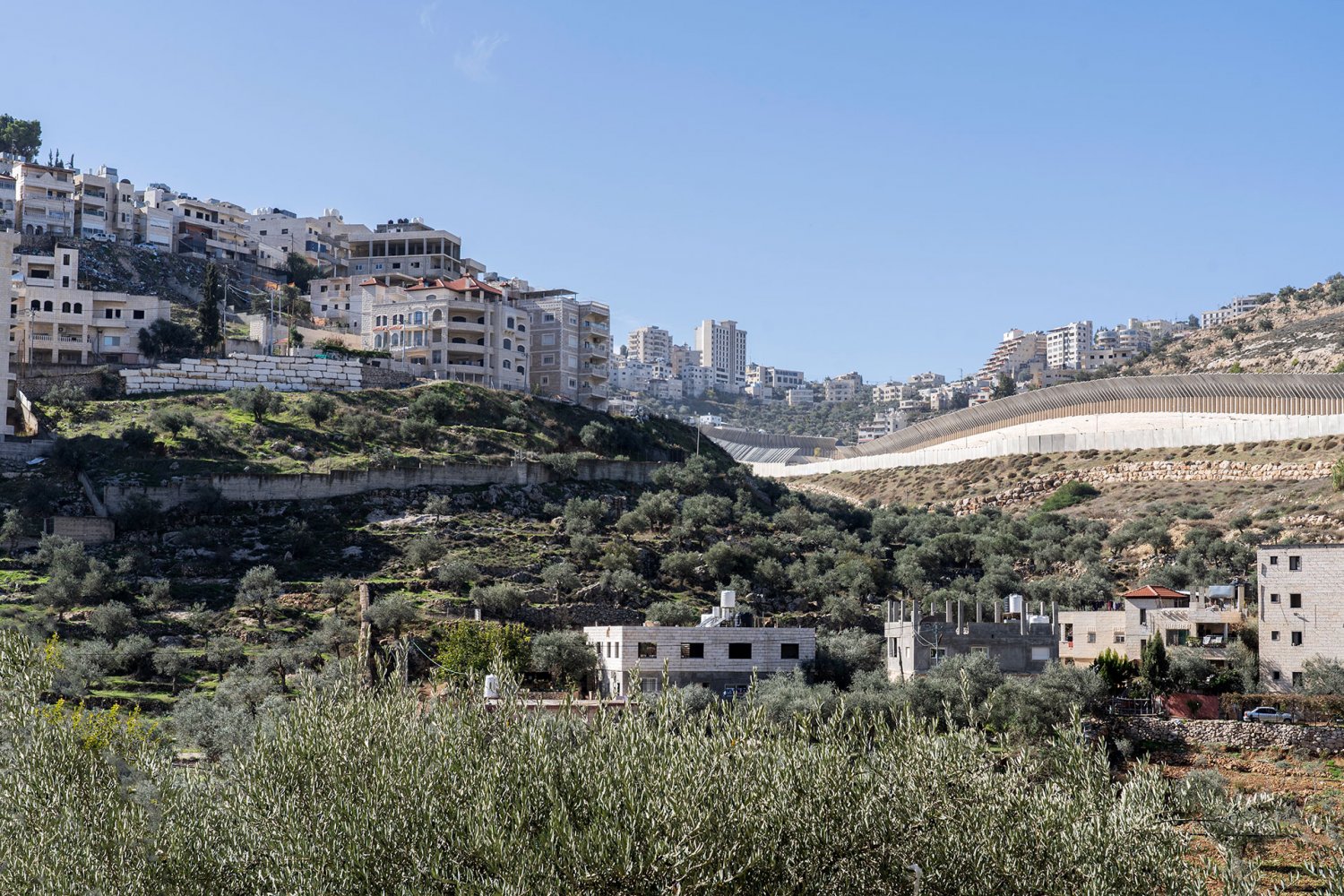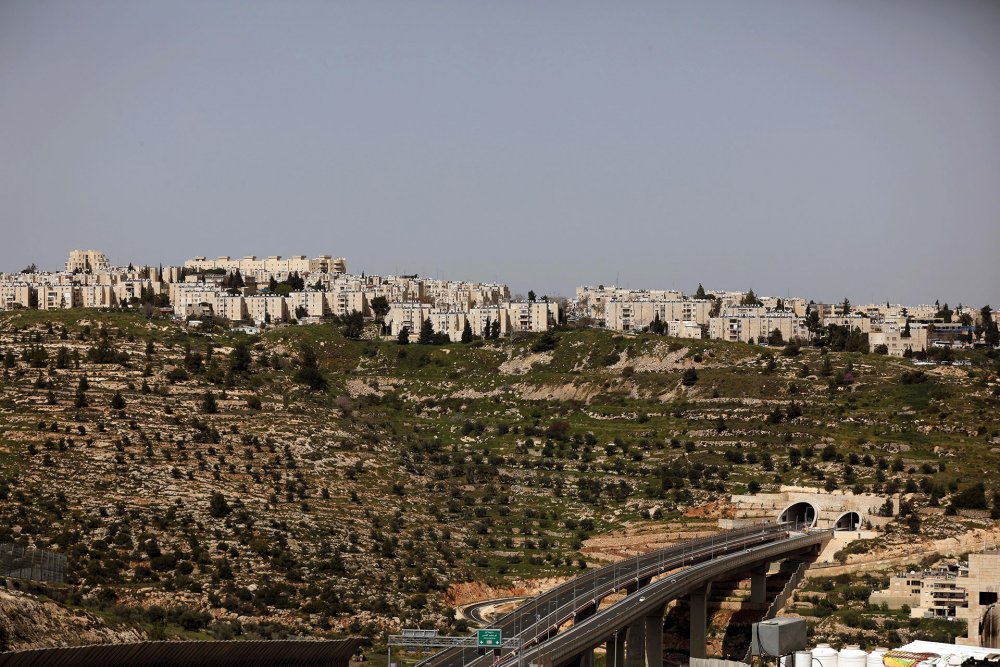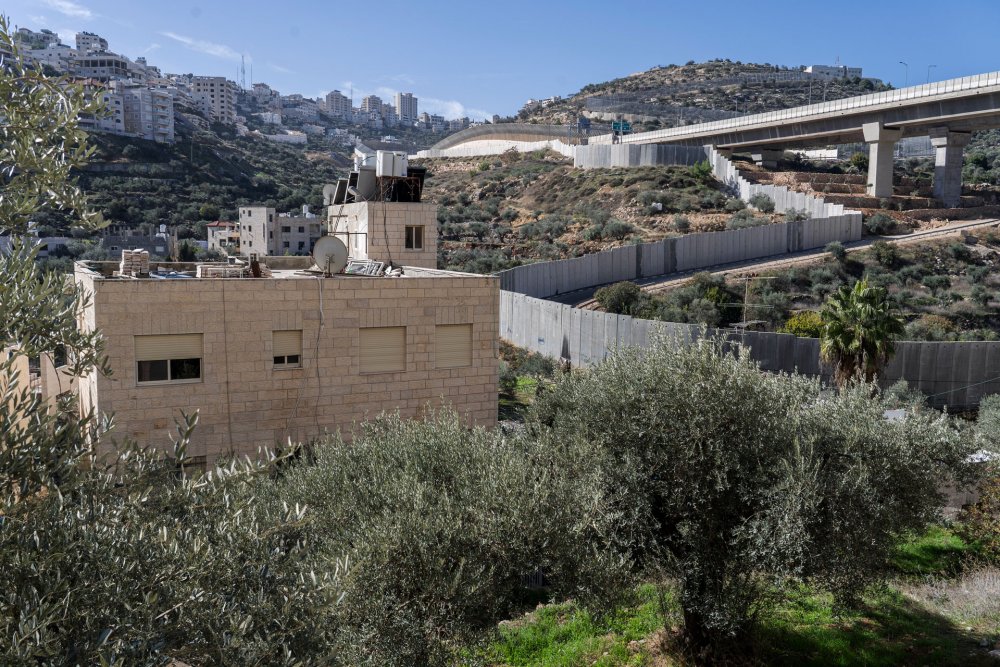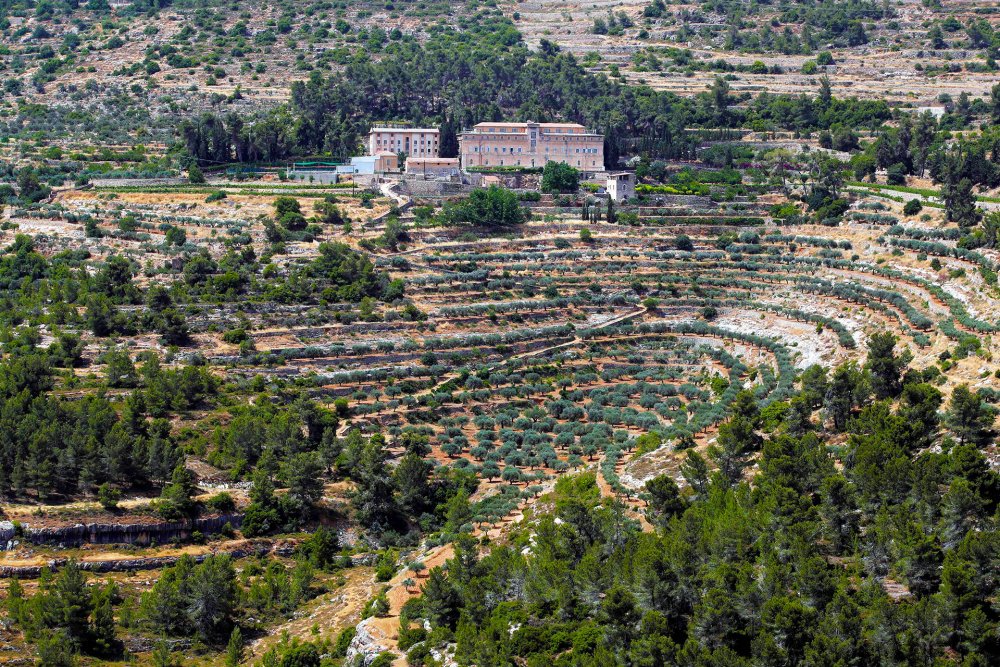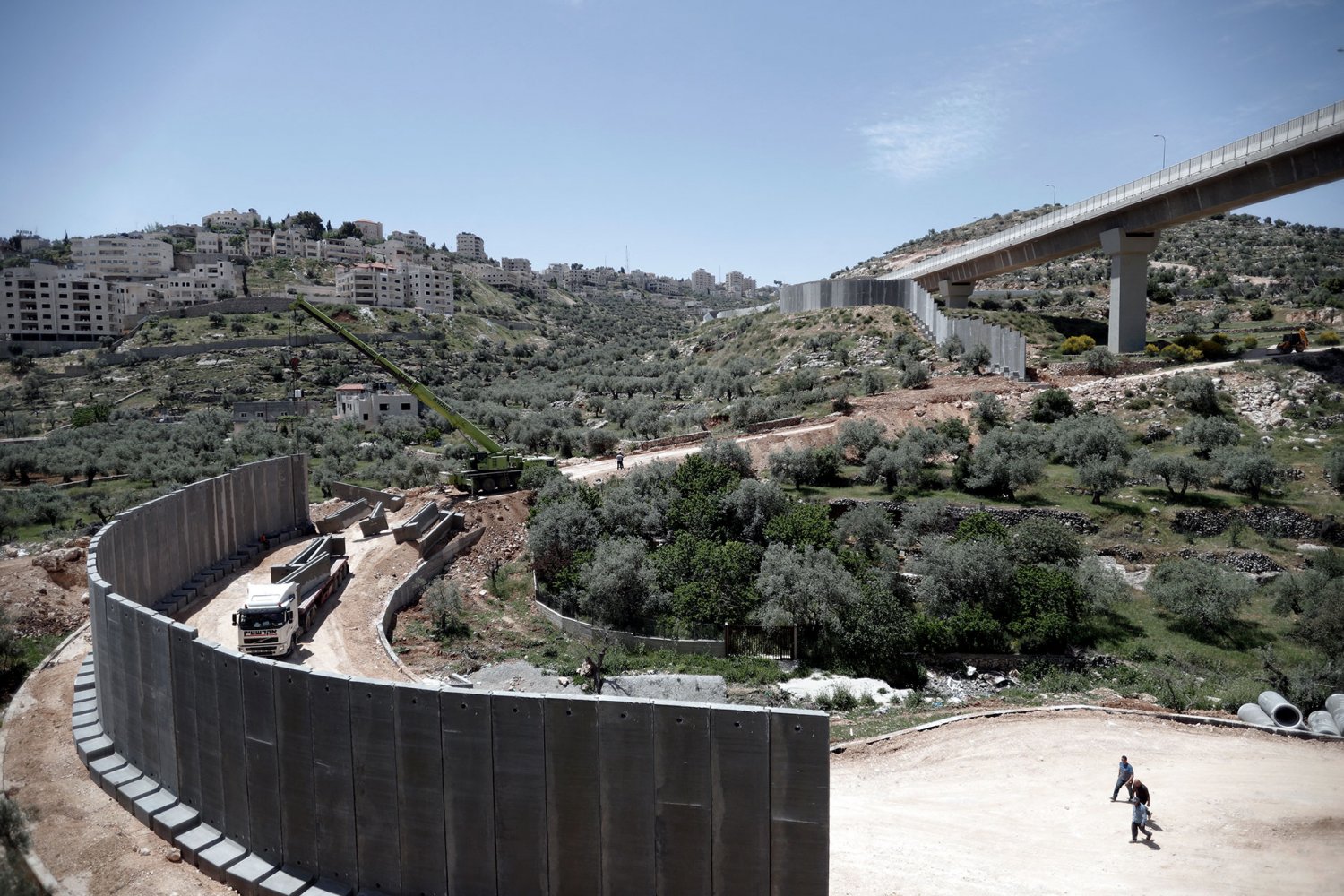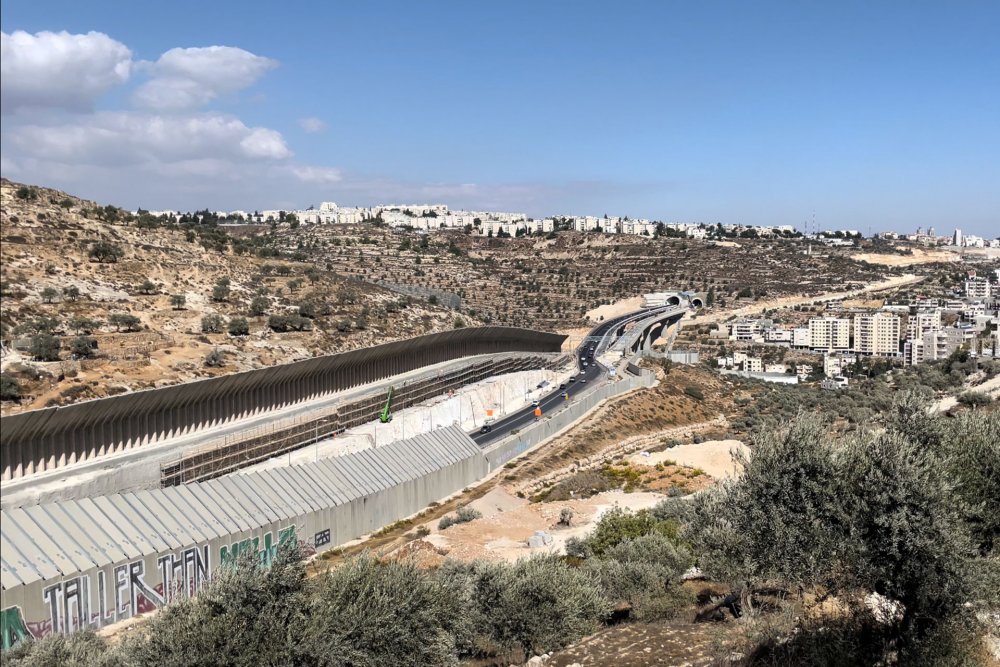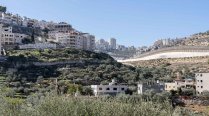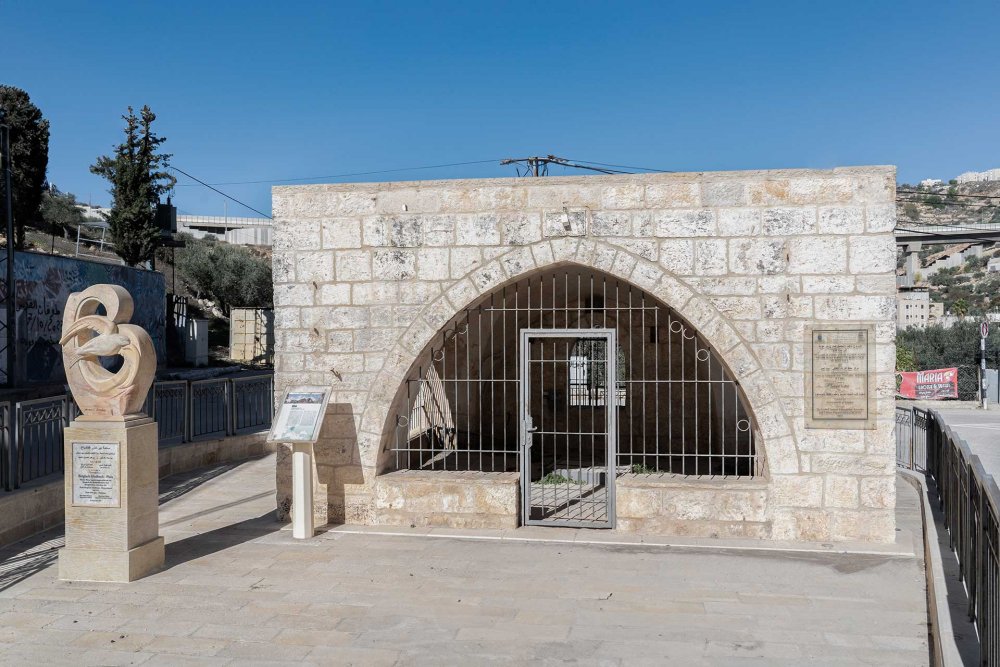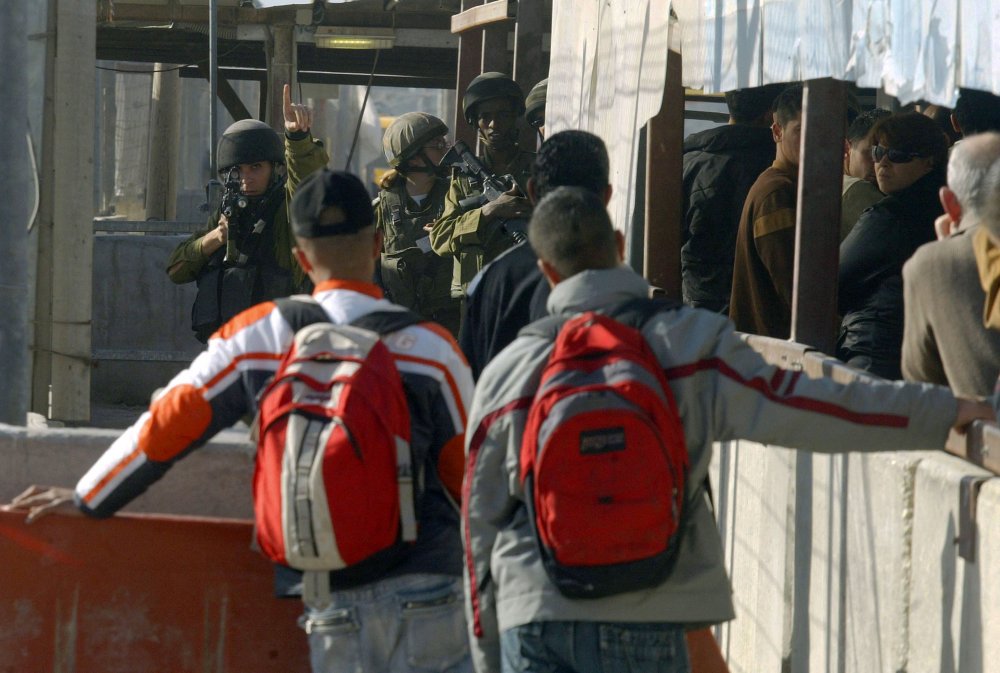Overview
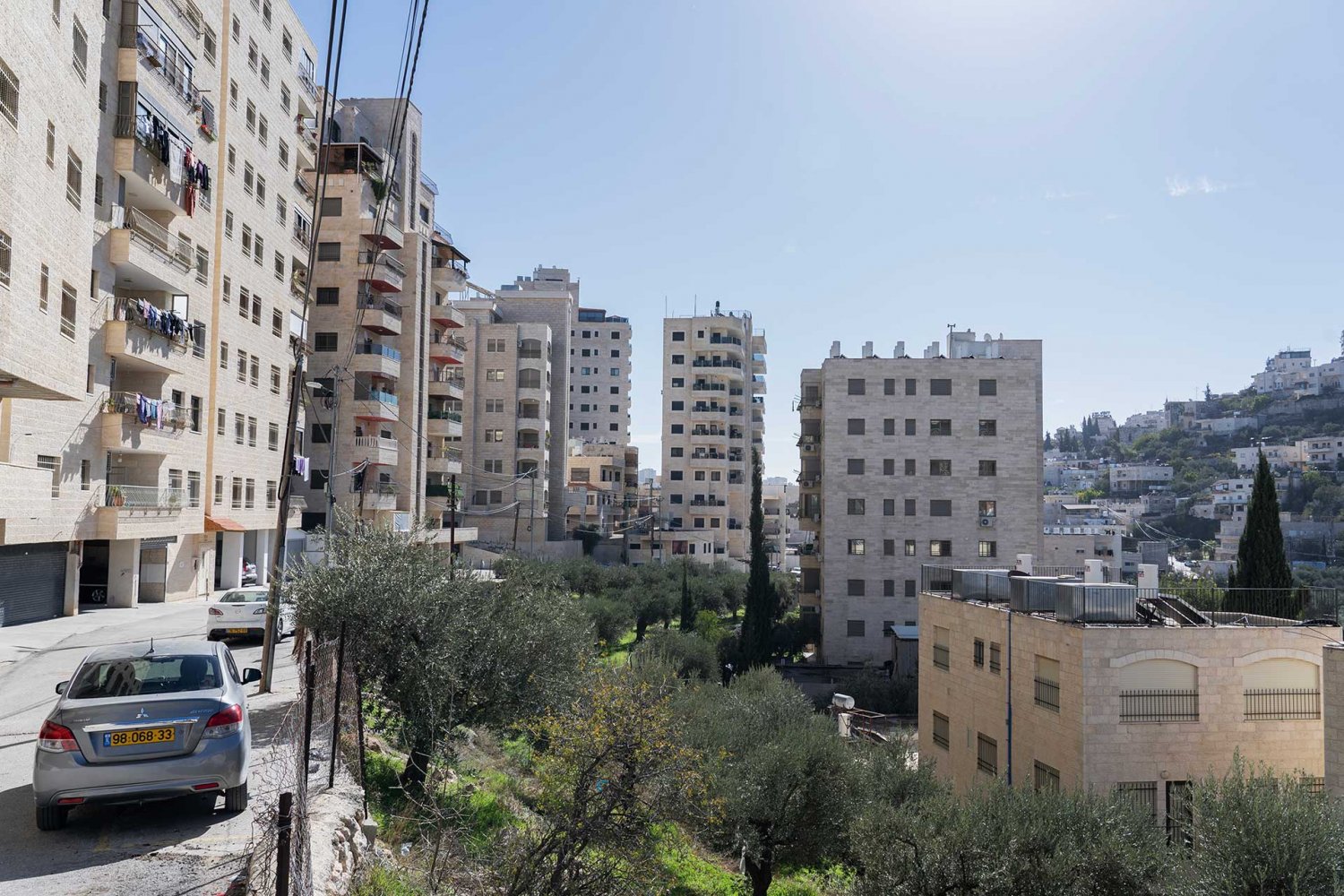
Credit:
Mays Shkerat for Jerusalem Story
Bir ‘Awna: The Neighborhood Israel Snatched from Beit Jala
Snapshot
Israel severed the Palestinian neighborhood of Bir ‘Awna from the West Bank town of Beit Jala, and then placed its residents in a highly precarious and challenging, even dystopian, legal status as well as barely tolerable living conditions.
Before Israel occupied the West Bank in 1967, Bir ‘Awna (Arabic for Well of Assistance), roughly 326 dunums in size,1 was a neighborhood of the town of Beit Jala in the Palestinian Bethlehem Governorate, just 2 kilometers from Bethlehem’s city center. It comprised 29 percent of Beit Jala’s total area.2
The name Beit Jala originates from Aramaic, meaning “home of the grass carpet.” The city itself was founded in 1912.3 After 1967, Beit Jala retained only five neighborhoods, known in Arabic as harat: Haret al-Samana, Haret al-Sarar, Haret al-‘Iraq, Haret al-Deir, and Haret al-Kanees.4
Bir ‘Awna is situated in a valley of the Slayeb Mountain north of Beit Jala that borders the southern municipal boundary of Jerusalem, the same valley that connects the famous Cremisan Monastery and its lush vineyards to the west with the urban centers of Beit Jala,5 Bethlehem, and Beit Sahur to its east, forming a corridor of sorts that has been a mainstay of Palestinian social, cultural, and economic life in the region for centuries.
Today, Bir ‘Awna is bordered by the Israeli Separation Wall and the settlement of Gilo from the north, Beit Jala city center from the south, ‘Ayda refugee camp from the east, and the wall and al-Makhrour Valley from the west.6
Population
As of 2021, an estimated 1,526 persons lived in Bir ‘Awna,7 but the exact number is likely higher due to rapid population growth.
Historical Background
The ancient area of Bir ‘Awna received its name from its biblical connection to the Virgin Mary, who is said to have rested there with Joseph and baby Jesus as they fled King Herod for Egypt. The family arrived in the village seeking to quench their thirst with water from the well, but they found the water level to be low. As the story goes, Mary prayed for the water to rise, and by the grace of God, a miracle occurred and the water did rise, saving the holy family and allowing them to continue on their flight to Egypt. Hence, the well became known as the Well of Assistance.8
For centuries, the ancient natural spring was a critical source of water for nearby villages, including Beit Jala, whose residents relied on the spring for their livestock and irrigation. In fact, it has been so central to area residents that traces of the ropes that villagers used to pull up buckets from the depths of the well are still visible on the edges of the well’s rocky opening.
As a result of the 1967 War, Israel occupied the West Bank, including East Jerusalem, on June 7, 1967. Shortly thereafter, Israel incorporated Jerusalem under its municipal jurisdiction and expanded the 6 sq km boundaries of (East) Jerusalem, as it had formerly been delineated by Jordan, to about 71 sq km. In so doing, the state absorbed 28 Palestinian neighborhoods, refugee camps, and villages that had formerly lain outside the city boundaries, including Beit Hanina, Shu‘fat, and Kufr ‘Aqab, of course including their lands (see Where Is Jerusalem?). Some of these localities were also arbitrarily split by the boundary, which was drawn with an eye toward expropriating the most land with the fewest Palestinians, without regard to preexisting Palestinian geopolitical realities. One of these was Beit Jala. Beit Jala, a Palestinian Christian town in the Palestinian Bethlehem Governorate that historically included Bir ‘Awna, was divided, with Bir ‘Awna now severed from it and enveloped into the Israel-defined Jerusalem municipal limits, while the rest of its neighborhoods remained outside the city limits in the occupied West Bank under a different political and legal regime. This split a formerly cohesive Palestinian residential area in two, with a different legal status for the residents of each area.
That same year, Israel unilaterally annexed the land-rich, population-scarce Bir ‘Awna, seizing 225 of its 326 dunums, amounting to 69 percent of the neighborhood’s total area.9 The expropriated land was used for the construction and expansion of the Jewish settlements of Gilo in 1970 (on the hilltop above Bir ‘Awna) and Har Gilo in 1972 (see The Three Israeli Settlement Rings in and around East Jerusalem: Supplanting Palestinian Jerusalem and The History of Israeli Settlement Expansion in and around East Jerusalem from 1967 to 1993). Gilo was subsequently expanded several times—to its south, southwest, and southeast.10
Khallet Hamameh was also forcibly integrated into Israeli municipal Jerusalem.11
Implications for residents’ legal status
After it occupied East Jerusalem in June 1967, the Israeli army conducted two censuses in the areas it newly occupied. The first (rushed and inaccurate) census was conducted in June; the second, in late September. Only those Palestinians who were physically present in their homes were allowed to be counted, excluding tens of thousands of Jerusalemites12 who were deemed to be physically outside the new municipal boundaries. Most of those who were counted were allowed to apply for permanent-resident status (see Precarious, Not Permanent: The Status Held by Palestinian Jerusalemites, Parts 1 and 2). However, residents of Bir ‘Awna were designated West Bank residents, even though Bir ‘Awna fell within the newly enlarged Israeli Jerusalem municipal boundaries. As a result, Bir ‘Awna’s residents were issued West Bank identification cards (orange-colored at that time), and their registration and administration fell under the Israeli military government of the West Bank, known as the Israeli Civil Administration.
After the Oslo Accords were signed in the mid 1990s, the newly established Palestinian Authority (PA) was tasked with issuing West Bank IDs (henceforth referred to as PA IDs), although the Israeli military maintained its control over the Population Registry through the Coordination of Government Activities in the Territories (COGAT). This was perplexing for residents of Bir ‘Awna who, although officially considered to reside within the Jerusalem municipal boundaries, were issued orange IDs from the Civil Administration in 1967, until the PA was tasked with issuing West Bank IDs, just like the other residents of Beit Jala. Many residents thus received PA-issued (green) IDs from the PA after Oslo. But in 1995, Israeli authorities informed Bir ‘Awna residents holding these IDs that they had been living illegally in their own homes since 1967, and thus, they could face expulsion.
In 1995, Israeli municipal authorities issued a home demolition order to a family in Bir ‘Awna for expanding their home with additional rooms and facilities, constructed that same year. According to the family’s knowledge and that of other residents at the time, they were required to obtain a building permit from the Palestinian Bethlehem Governorate, not the Israeli Jerusalem Municipality.
After being informed that their house fell under the jurisdiction of the Israeli Jerusalem Municipality and that their orange IDs had been issued by “mistake,” the family applied to the Israeli Ministry of Interior requesting that this error be corrected by issuing them Israeli blue permanent-residents IDs instead.
In response, only the parents and two of the children were granted Israeli permanent-resident status allowing them to stay in their home. Three other children were denied, threatening their ability to visit their family or live in their own homes. This decision led nearly all 1,500 residents of Bir ‘Awna to realize they needed to challenge this legal and factual status that had been imposed upon them to avoid expulsion and property seizure by the state or even deportation.13
On June 28, 1998, Sharon Goldstein, advisor on political affairs to Ehud Olmert, then the city’s mayor, organized a meeting involving the Department of Health and Sanitation, a sewage company, and the committee of Bir ‘Awna to suggest the establishment of a municipal sanitation system in the Palestinian neighborhood. The proposal outlined that Bir ‘Awna would be integrated into the Israeli Jerusalem Municipality’s sanitation routes and connected to the city’s sewage system, with each household expected to incur a cost of approximately NIS 11,000 NIS (about $2,973).14 At that time, residents carried orange IDs. When the committee questioned why their waste could be processed in Jerusalem while they could not be, municipal officials dismissed the query as “a political question.”
Additionally, residents reported that Israeli settlers frequently approached them with offers to purchase their homes and properties. Na‘im Abu Sa‘d, the head of the Bir ‘Awna committee challenging expulsion at the time, said, “I was here before the State of Israel, and they ask me why I’m here—what kind of thinking is this?”15
In 1998, residents of Bir ‘Awna held a series of meetings with lawyers, Jerusalem politicians, and other stakeholders to protect their lands and homes from expulsion. On June 30, they invited Palestinian officials to their neighborhood to discuss practical solutions, with around 70 residents and 10 officials in attendance. This meeting was part of several efforts to address their case. A preparatory committee was formed with the Beit Jala Municipality to plan a future strategy session, which would include representatives from the Palestinian Legislative Council (PLC), Orient House, PA Ministry of Local Affairs, and Bethlehem District Governorate to analyze the situation and explore potential interventions.16
On January 22, 1999, the Israeli Jerusalem Municipality announced that Bir ‘Awna was “included” within the boundaries of Jerusalem that were established in 1967. The “mistake” was corrected from their end. This action ensured the incorporation of Palestinian neighborhoods and areas, effectively creating buffer zones. These efforts to alter the geographical and demographic landscape of Jerusalem are part of a broader strategy to reinforce Israeli control over the city.17
Residents of Bir ‘Awna therefore filed two petitions in 1996 and 1998 with the Supreme Court of Israel.18 While the cases were being deliberated between 1996 and 2005, Israeli authorities considered the residents of Bir ‘Awnato be living in their homes “illegally,” despite the fact that these same authorities had overseen the issuance of residents’ West Bank IDs before the PA even existed. As a temporary solution, Israeli authorities issued these residents special military exit permits allowing them to remain in their own homes and to enter and leave Bir ‘Awna “legally.”19
Over the course of a decade, approximately 1,000 Palestinians20 in Bir ‘Awna who managed to prove that they had never left the neighborhood since 1967 were approved to change their legal status to that of permanent resident and were therefore issued Israeli permanent-residency IDs instead of PA IDs. By 2004, the majority of the residents of Bir ‘Awna held Israeli permanent-residency IDs.
On June 14, 2005, the judge issued his final statement, noting that a mistake had been made in 1967 and many residents were not registered as they should have been.
However, this reversal of status was not granted to everyone. Around 500 individuals were not granted any status at all, meaning they could no longer reside in Bir ‘Awna and were compelled to file individual appeals to challenge their residency status, because they were unable to prove they had not lived outside of Bir ‘Awna or had temporarily left their homes for study or work.21 Generally speaking:22
- Between 1967 and 1995, individuals who had not temporarily or permanently moved away from their family homes and could prove they lived in Bir ‘Awna were issued Israeli permanent-resident status.
- Between 1967 and 1995, individuals who had temporarily moved away from their family homes or could not prove their residence in Bir ‘Awna were not issued Israeli permanent-resident status and were considered to be living in their homes “illegally.”
- Between 1967 and 1995, individuals who moved permanently or married out were denied any status that would let them return—even to visit.
- After 2004, individuals holding PA IDs who married residents of Bir ‘Awna and moved there to live with their spouses who now hold Israeli permanent residency were issued, or will be issued, military stay permits through the family unification process.
- After 2005, all Palestinians from Beit Jala who hold PA IDs and did not reside in Bir ‘Awna between 1967 and 1995 but wished to move there due to property ownership or to naturally just enjoy another neighborhood are considered “illegal immigrants.”23
Being born in Bir ‘Awna was not considered sufficient proof to secure residency, nor was having a long-standing connection to the land or owning property. On the contrary, Israeli settler-colonial policies aimed to expel Palestinians and seize the land through both direct and indirect means, with the Israeli judicial system serving as a fundamental tool to achieve this goal. Residency laws and policies are among the many mechanisms that enable Israel to seize land under the guise of legal authority.24
Thus, over 50025 Palestinians were deemed to have failed to prove that they lived in Bir ‘Awna between 1967 and 1995. As a result, their applications for permanent residency were denied, placing them at significant risk of being expelled from their homes.
The Impact of the Separation Wall, Closure and the Permit Regime, Land Loss, and Settlements on Bir ‘Awna
In June 2002, under the pretext of security, Israel decided to build the Separation Wall, including in and around Palestinian East Jerusalem. The torturously routed wall snakes 140 km in and around Jerusalem. The wall dismantled and fragmented Palestinian East Jerusalem and severed it from the rest of the West Bank. At the same time, the wall enclaved Bir ‘Awna off from Beit Jala into East Jerusalem, thereby initiating a long-term process of ghettoization (see Al-Jidar: An Instrument of Fragmentation).
Israel’s ever-expanding occupation infrastructure—including checkpoints, the Separation Wall, and settlements—necessitates the confiscation of more and more Palestinian land. Indeed, land seizure through military orders has been a fixture of Israel’s military occupation since 1967, especially when it concerned the construction of Jewish settlements (see The History of Israeli Settlement Expansion in and around East Jerusalem from 1967 to 1993).
One of the main ways Israel expropriates Palestinian land is through the Absentees’ Property Law. With regard to the 1967 occupation of the West Bank, including East Jerusalem, Israeli law dictates that Palestinians who were absent from the city on June 28, 1967, when de facto Israeli annexation became effective, and who were present in a country Israel considered to be an enemy state (i.e., neighboring Arab states), are considered “absentees.”26 This loose definition has allowed Israel to apply the term to Palestinians who were abroad on that date and to Palestinians who did not, in fact, leave the West Bank but who were counted as residents of the West Bank in the 1967 Israeli census.27 Indeed, this also means that lands and properties of owners who were issued West Bank permits (e.g., the children of families who moved out of Bir ‘Awna before 1996) are at high risk of having their property appropriated because they are classified as “absentees.”
Importantly, the law continues to be applied to this day with regard to Palestinian land newly annexed by Israel, including for the construction of the Separation Wall. This is because of the broad applicability of the Absentees’ Property Law, which effectively transfers Palestinian properties to the Israeli state. For example, in November 2004, a number of Palestinian landowners from Beit Jala and Bethlehem were denied military permits to access their lands that Israel had de facto annexed as part of Jerusalem; their lands were transferred to the office of the Israeli Custodian of Absentee Property.28
On March 3, 2006, Israel issued a military order confiscating privately owned Palestinian land in Bir ‘Awna29 for the construction of a 1.5 km extension of the Separation Wall, effectively severing Bir ‘Awna from the rest of the West Bank and enclaving it into Jerusalem.
In 2006, 58 Palestinian landowners in Bir ‘Awna, as well the Beit Jala Municipality, appealed the order before the Israeli Military Appeals Committee, which debated the matter for over seven years. During that time, Israel made several changes to the planned route of the Separation Wall. For example, several houses that were slated to be cut off from Beit Jala by the wall were spared by rerouting it. As a result, in April 2007, the Israeli Ministry of Defense published a map of the revised route of the Separation Wall on its website: the wall in Bir ‘Awna would now only extend 1.2 km and would be built at a distance of 100 meters from Palestinian homes.30
The relative success of the Bir ‘Awna appeal inspired others to do the same. In December 2010, the Salesian Sisters’ Convent at the Roman Catholic Cremisan Monastery, a seventh-century Byzantine monastery, joined the appeal. This is because, in 2006, Israeli occupation authorities ordered that part of the Separation Wall be built in the Cremisan Valley, west of Bir ‘Awna. The 170 hectare Cremisan Valley hosts the monastery, convent, and adjacent vineyards where wine has been produced since the 19th century. According to the order, the wall would pass directly in front of the convent, which would have severed it and its school from the rest of the West Bank, while the Palestinian community that it serves would have remained on the other side of the wall. Therefore, this would have required the construction of a military checkpoint at the entrance to the convent and school, subjecting children, teachers, and convent residents to complete military control, including by needing to receive military permits to access the school.31 To avert this, Israel issued another military order in 2011 to leave the women’s convent on the West Bank side of the Separation Wall. However, the amended route severed the convent from some of its land and from the men’s monastery, which was slated to remain on the Jerusalem side of the wall.
On April 24, 2013, the Israeli Military Appeals Committee denied the convent’s 2010 appeal, stating, “The new route was based on operational considerations and the harm it would cause was proportionate.”32 Residents of Bir ‘Awna, the Beit Jala Municipality, and members of the Cremisan Monastery appealed this decision before the Supreme Court of Israel. Nonetheless, on August 17, 2015, Israeli authorities renewed the construction of the Separation Wall in Bir ‘Awna, despite the fact that the legal proceedings were still underway pending resolution. To be sure, this was Israel’s way of creating permanent facts on the ground. As a result, Israeli bulldozers uprooted approximately 120 olive trees and leveled lands, including a section of bypass road 60, on which Palestinians rely for travel to and from Jerusalem.
This triggered another round of legal battles that ultimately failed to secure the petitioners’ redress. On January 21, 2016, the Supreme Court denied the two petitions submitted by the Beit Jala Municipality, Bir ‘Awna landowners, and the women’s convent in the Cremisan Valley against the construction of the Separation Wall on their lands.33 As a result, Israel appropriated and leveled approximately 3,147 dunums of land in the area, amounting to 22 percent of Beit Jala land, to expand the borders of the Israeli Jerusalem Municipality through the construction of a 1.3 km extension of the Separation Wall, and to build and expand the Jewish settlements of Gilo and Har Gilo.34 Critically, an estimated 3,000 dunums of agricultural land, including olive groves, orchards, and beehives that for centuries had provided local Palestinians with their economic livelihoods, were confiscated.35
Ghettoization and Economic and Agricultural Consequences
Today, Bir ‘Awna is separated from the Old City of Jerusalem by three military checkpoints and the Separation Wall, and from Beit Jala by an invisible but highly enforceable bureaucratic wall (enforced by mobility permissions derived from IDs). Ultimately, despite years of legal battles, Israeli military and state authorities, supported by the Supreme Court, only made minor changes to their plans to establish permanent facts on the ground.
One of these minor changes was the installation of “agricultural gates” in different parts of the Separation Wall. These gates ostensibly allow Palestinian farmers “access to their lands,” from which they were severed by the wall, at certain times of the day.36 To build these gates, which do nothing more than control Palestinian movement, Israel confiscates more land and uproots more trees.37
Indeed, Palestinian farmers in villages near the wall face additional challenges. They must obtain a military permit from COGAT to access their land and harvest their crops. Many residents are restricted from entering the agricultural areas behind the wall under the pretext of "security clearance.” On October 19, 2015, the occupying authorities prevented farmers, volunteers, and employees of the Palestinian Ministry of Agriculture from harvesting olives from the lands in Bir ‘Awna. According to farmer Gress Ayad Ghanimat, who lives in the Bir ‘Awna area and owns numerous olive trees, he was barred by Israeli soldiers from picking the olives on the grounds that the area is a closed military zone, and anyone attempting to approach it risks danger.38
As a result, many Palestinian farmers face constant uncertainty regarding their rights to their lands, making them dependent economically on the whims of the Israeli army and government. Inevitably, this leads to diminished Palestinian economic and agricultural activity, eroding the community’s self-sustainability.39
A 2021 survey of Bir ‘Awna families found that 95 percent of the 86 sampled households reported living in middle-to-upper economic conditions.40 However, these findings may not fully represent the community, as the population is growing and is not accurately counted.41 Interviews conducted by the Jerusalem Story Team in 2023 revealed that residents are now facing significant hardships due to rising housing prices, driven by increased demand amid Jerusalem’s broader housing crisis for Palestinians. The economic situation in Jerusalem has also significantly deteriorated since October 7, 2003, and it remains too early to assess the full impact of the ongoing genocidal war in Gaza on the local economy and living conditions.42
The (Il)logic of Demographic and Urban Palestinian De-development
Israel’s agenda of securing a Jewish majority in Jerusalem has been part and parcel of every Israeli government since the city was occupied in 1967 (see The History of Israeli Settlement Expansion in and around East Jerusalem from 1967 to 1993). This strategy has also been reflected in Israel’s urban planning policies. While expanding Jewish settlement within the expanded municipal boundaries of Jerusalem, the Israeli government has also curtailed Palestinian urban growth. Indeed, Israel’s Jerusalem Municipality only began to prepare outline plans for Jerusalem’s Palestinian neighborhoods in the early 1980s, and based on the 1965 Planning and Building Law, which prioritized Israeli interests.43
The first Israeli Jerusalem master plan, known as the 2000 Local Outline Plan Jerusalem, was a citywide urban planning and zoning scheme. It permitted Palestinians to build on only 13 percent of their land, yet obtaining a building permit is close to impossible. Indeed, Palestinians applying for building permits face exorbitant fees, undue delays, onerous requirements,44 and at the end of all that, almost certain denial.45
As a result Palestinians in the city, including those in Bir ‘Awna, build without permits. Without a permit, the home (if it belongs to a Palestinian) will be classified as an “illegal” structure and slated for demolition.
Indeed, after mere months of resuming construction on the Separation Wall around Bir ‘Awna, Israel began demolishing Palestinian homes in the area, because they were built without permits. In August 2016, the Jerusalem Municipality ordered the demolition of the first two houses in Bir ‘Awna that were built in 1991, resulting in the forcible displacement of 20 Palestinians.46 Adding salt to injury, Israel charges Palestinians for the demolition of their homes, leading some Palestinian families in Jerusalem to tear down their own homes to avoid the high costs, which can reach up to tens of thousands of US dollars.47 From January 1, 2018 to August 1, 2024, Israel destroyed approximately 28 homes displacing 17 people in Bir ‘Awna. It also destroyed buildings under construction, affecting 108 people.48
The combination of Israeli housing policies, land confiscation, and the construction of the Separation Wall and settlements has effectively besieged Bir ‘Awna neighborhoods, preventing any possibility of natural demographic or urban growth.
Over time, these policies have resulted in the isolation, de-development, and ghettoization of Bir ‘Awna.
Municipal Services and Taxes
Residents of Bir ‘Awna who were ultimately issued Israeli permanent-resident permits were forced to pay tens of thousands of US dollars for the Municipal Property Tax arnona retroactively since 1967, although they never received municipal services from the (Israeli) Jerusalem Municipality.
But as far as the residents were concerned they had been part of the Beit Jala Municipality, which provided them with services, much or all of that time. And in fact, while the Jerusalem Municipality has provided no basic services such as trash collection, the Beit Jala Municipality has done so. It has then sent the residents of Bir ‘Awna an annual payment request in return for these services—meaning residents are now double-billed. However, residents often do not pay the Beit Jala bills, because they cannot afford to pay two municipalities for the same services.49
So what services do residents get in return, and what do they have to do to get them?
Water
Water in Bir ‘Awna’s well is severely limited due to Israeli policies banning its development for consumption and agriculture. Fewer than five families in the neighborhood benefit from the well’s water, in addition to only one business.50
Moreover, although Bir ‘Awna was formerly part of Beit Jala, today Israeli law forbids the Beit Jala Municipality to develop the neighborhood’s well, as it falls under the “jurisdiction” of the Israeli Jerusalem Municipality. Before Israel actively forced its control of the Bir ‘Awna neighborhood in the late 1990s, the residents of Beit Jala, including those from Bir 'Awna, had built a reservoir on a high hill. Water from a well was pumped into this reservoir, which then allowed the water to be repumped and distributed to the families in Beit Jala.51 Eventually, Israel prohibited residents of Beit Jala, including those from Bir ‘Awna, from developing the well and utilizing its water.
Nowadays, the majority of the houses in Bir ‘Awna receive their water from the Israeli water company Hagihon Ltd., a sewage and water company in Jerusalem.52 After being issued Israeli permanent residency in 2004, Bir ‘Awna residents with permanent-resident status were left with no choice but to register with Hagihon. Why?Because Israeli law requires Palestinian permanent residents in Jerusalem to prove their “center of life” lies in Jerusalem, including by presenting utility bills or invoices (including water) as part of the “evidence.”
However, there is a further catch. Israelis do not enter neighborhoods behind the wall; that stopped over a decade ago. So residents of Bir ‘Awna did not actually receive their water bills. When they showed up at the Ministry of Interior office in East Jerusalem to apply for any routine request, they were queried, “Where are your water bills?” When they went to the water company to ask for their bills, company clerks directed them to take a photo of their own water meters every month and submit it to the company in order to be sent a bill which they could, in turn, take to the Ministry of Interior as part of the packet of documents they must compile to “prove” their “center of life.” Consequently, each month, Palestinian residents of Bir ‘Awna send the company a photo of their water meters to avoid debts and compile the documents to be ready for their next required visit to the Ministry of Interior.
Price variance
In 2020, the disparate water pricing structures in Beit Jala and under Gihon exemplify a broader strategy that exacerbates the economic difficulties faced by Palestinian residents in Jerusalem, contributing to their displacement. Beit Jala’s fixed monthly fee of NIS 50 per household for water services, with no additional connection costs, offers a more manageable expense for low-income families. By contrast, Gihon’s consumption-based pricing, with a standard rate of 7.385 NIS/m³ for up to 3.5 m³ per person per month and escalating to 13.461 NIS/m³ for higher usage, imposes a variable and potentially prohibitive cost burden on households, particularly those struggling with poverty. This tiered pricing structure can lead to disproportionately high water bills for poorer families, further straining their finances and making it increasingly difficult to remain in Jerusalem. Such economic pressures are part of a broader policy framework that not only burdens Palestinian residents with higher living costs but also serves to reinforce socioeconomic barriers, ultimately contributing to their displacement from the city.53
Bir ‘Awna’s well, like many wells in the occupied West Bank (including East Jerusalem), is targeted by Israel’s settler-colonial strategies aimed at controlling the land, people, and natural resources. Different laws promulgated under the pretext of security not only restrict Palestinian access to adequate and safe water for drinking; they systemically target water resources Palestinians use for agriculture, further leading to Palestinian reliance on the very Israeli services that can then become the cause of their financial suffering and exposure to the risk of status revocation.54 If and when that occurs, they are left stateless.
Sewage
The sewage system in Bir ‘Awna is the responsibility of Beit Jala Municipality. As of 2020, 100 percent of the houses were connected to the public sewage networks. Connection and maintenance are free of charge.55
Garbage/Waste Removal
Solid waste collection is managed by Beit Jala Municipality. Bins and containers are generally emptied twice a day. The fee per household for this service is NIS 325.56
Education
There are no primary or secondary educational institutions in Bir ‘Awna, neither public nor private.57 However, according to the 1949 Israeli Compulsory Education Law, Bir ‘Awna’s children, like all Palestinian Jerusalemite children, are entitled to free public education from age 5 to 18.58 Thus, families either enroll their children in expensive private Christian schools in Beit Jala (outside the municipal boundaries of Jerusalem, in the West Bank) and pay steep fees, or public schools in Beit Safafa, which is the closest neighborhood to Bir ‘Awna inside municipal Jerusalem but it lies on the other side of the checkpoint. The former option requires a special case to be made before the Ministry of Interior to grant an exception for families living behind the wall who wish to enroll their children in private, excellent education schools. In the case of Bir ‘Awna, the families continued to enroll their children in schools in Beit Jala after being issued their new status.
Either way, children and anyone transporting them must endure the hours-long wait in both directions going to and from school, as there are no schools inside the checkpoint for Bir ‘Awna.
Furthermore, children’s school certificates are used as one form of proof of residence in Jerusalem (see Precarious Not Permanent: The Status Held by Palestinian Jerusalemites, Part 2). That is, among the many documents Palestinian residents are required to present for any application from the Ministry of Interior (e.g., renewing a driver’s license or ID), certificates for school-aged children are on the list. If the school issuing the certificate is under the jurisdiction of the PA in the West Bank outside the municipal boundaries of Jerusalem, the Ministry of Interior uses the certificate as an indication that the family lives in the West Bank, and that, therefore, their “center of life” is not in Israel, exposing them to the risk of revocation of their permanent-resident status and with it, their right to live in Jerusalem. If this happens, they can be immediately deported out of the country and lose all their rights to education, health care, social services, and so on.
In some cases, unofficial exceptions can be made based on socioeconomic status. Palestinians who live behind the wall and have the financial means to afford private schools can manage to bypass this requirement.
Ultimately, the “center of life” policy depends on the judgment of the Ministry of Interior official assigned to the case (see Precarious Not Permanent: The Status Held by Palestinian Jerusalemites, Part 2).
Health care
While Palestinian residents of Jerusalem have access to some level of health care, it is certainly not at the level enjoyed by Jewish citizens.
Bir ‘Awna currently has no health care centers or services.
According to the residents of Bir ‘Awna, in 2013, a Palestinian investor built a health clinic in the neighborhood and applied for a building permit from the Jerusalem Municipality. However, his application was rejected, as Palestinians’ applications for building permits in Jerusalem commonly are. Instead, the building intended to serve as a clinic was used as a vegetable market for several years until the municipality demolished it.59
The nearest clinic is in Beit Safafa, though reaching it requires residents of Bir ‘Awna to cross one of three military checkpoints—Checkpoint 300 (or the Bethlehem checkpoint), the Beit Jala checkpoint, or the Beit Sahur checkpoint. The average time that Palestinians spend to pass a checkpoint in one direction can exceed two hours (see Jerusalem: A Closed City and Checkpoints, Part 1: Severing Jerusalem).
Even more critically, ambulance services are not permitted by the Israeli Magen David Adom ambulance company to enter Bir ‘Awna or any of the other Palestinian neighborhoods behind the Separation Wall (see Neighborhoods beyond the Wall). Rather, they wait for the patients on the Israeli side of the military checkpoints. As a result, many families are forced to use their cars or taxies to pass the checkpoint and reach the ambulance in order to take their ill family member to the hospital, which of course is also on the Israeli side of the Separation Wall. Once a patient is hospitalized, any visit by the patients’ family members also entails passing the checkpoint on the way out and on the way back in, with hours of time lost to waiting (see Ibrahim's Story).
Transportation
There are no public transportation services in Bir ‘Awna. The Jerusalem-Beit Jala bus does not even pass by the neighborhood. Residents, who are suffering economically, are thus forced to invest in private cars or rely on costly taxies to go any distances. This situation resulted in a disproportionate number of private cars in the area, creating a shortage in parking spaces that, in turn, has led to intercommunal problems.
Conclusion
Israel’s appropriation of Palestinian land, properties, farmlands, and natural resources in Bir ‘Awna—as elsewhere in the occupied Palestinian Territory—is part of Israel’s strategy of Judaizing the city. Indeed, many of these confiscated lands and resources are funneled to the Jewish settlements of Gilo and Har Gilo, built illegally on occupied Palestinian land near Beit Jala. This deliberate strategy, coupled with the denial of basic services to Bir ‘Awna’s residents and the area’s general de-development, thus advances Jewish supremacy in Jerusalem. Indeed, Gilo and Har Gilo are extensive settlements and resemble large towns or small cities. In promoting the settlement of Gilo, the Jerusalem Municipality’s website advertised the following:
“[There] are many buses that reach all parts of Jerusalem . . . There are plenty of places to go such as mini-malls, grocery stores, clothing shops, and restaurants . . . There are health clinics, banks, a post office, and community centers which have programs for all ages . . . There are many parks and playgrounds in Gilo. One of them is the large JNF park which is a popular spot that people visit from all parts of Jerusalem. From this neighborhood, you can see beautiful views and the mountains. The buildings in this area have similarities to the Old City with arches and gateways to inner courtyards.60
Meanwhile, Bir ‘Awna and its residents continue to suffer from land confiscations, limited or no health, education, water, and transportation services, asphyxiating checkpoints, and the ever-present threat of banishment due to Israel’s oppressive occupation infrastructure and permit regime.
This is what it means for a Palestinian neighborhood to end up on the wrong side of Israel’s Separation Wall in a neighborhood where the state wants the land, but not the people.
Contributors
Researcher and Writer: Amina Abdulhaq Jerusalem Story
Editors: Nadim Bawalsa, Kate Rouhana Jerusalem Story
Appendix: Methodology
Introduction
This appendix details the data collection instruments, methods, and challenges encountered during field research on this Backgrounder.
Overall, the field research was conducted from March 2023 to September 3023. It took longer than a typical field research effort due to the complexity of the case and the challenges that are detailed below.
Languages of Research
The research was conducted in three languages: Arabic, English, and Hebrew. This multilingual approach aimed to capture a broad spectrum of data from diverse sources. It was also critically important to speak to residents in their own language as part of establishing and maintaining trust.
Primary Data Collection
The following methods were used to gather primary data:
- Survey
An attempt was made to conduct a comprehensive survey of Bir ‘Awna residents:
a. What types of information were collected?
- i. The survey aimed to collect information on various aspects including the economic situation, living conditions, housing conditions, hardships, legal status, legal procedures, and instances of injustice.
b. In what language was the survey administered?
- The survey was administered in Arabic.
c. How was the survey administered?
- The survey was administered digitally via a questionnaire.
d. How many questions were included in the survey?
- The survey included 30 questions.
e. How were the questions developed?
- The questions were developed after conducting desk research and 20 interviews with focal points, which helped to inform and refine the questionnaire.
Approximately 50 messages were sent to locals in Bir ‘Awna through three local residents acting as intermediaries. Only three responses were received, indicating a low response rate.
The survey process was conducted in the period May–August 2023.
Challenges: Despite assurances of anonymity, the survey faced significant challenges. Residents were hesitant to participate due to concerns that their responses could be linked to their personal identities. This fear was prevalent despite the survey being anonymous.
Access: In the timeline, the Jerusalem Story field team recorded all travel time and waiting periods at checkpoints, including delays due to traffic and waiting for people. The total time spent on these activities is approximately 10 working days.
- Individual interviews
Over 50 interviews with individual residents of Bir ‘Awna were conducted as part of the research process. At some interviews, several individuals or whole families participated together.
All interviews were conducted anonymously to address privacy concerns.
a. How were people selected for interviews?
- Residents of Bir ‘Awna aged 18 and above were selected for interviews. The field team reached out to everyone, understanding that not all would be willing to participate due to safety concerns.
b. Where did the interviews take place?
- The interviews took place in Bir ‘Awna.
c. Over what time period were the interviews conducted?
- The interviews were conducted from March 2023 to September 2023.
d. Was the same set of questions used, or were they uniquely tailored?
- The same set of questions was used, but they were modified based on age, gender, and legal status.
e. What was the objective of the interviews?
- The objective was to gather accurate information from residents of the neighborhood and to amplify their voices while writing about their experiences.
f. How was the data analyzed?
- The data was analyzed by reviewing all notes and validating them with official sources and fact-checking. Additionally, thematic analysis was conducted to identify common patterns and insights across the interviews.
Challenges: Participants were hesitant to disclose some types of information. The sensitive nature of the research topic and the potential for severe repercussions from the occupation authorities likely contributed to the reluctance of some individuals to fully disclose information.
Secondary Data Collection
The following methods were used to gather secondary data:
- Desk research
Initial data collection involved extensive desk research using various online sources and official records. This approach was necessary to gather comprehensive information about Bir ‘Awna.
The researcher examined online databases, official reports, and academic publications developed by Palestinian, Israeli, and international professionals and organizations.
The aim was to collect all available data about the neighborhood.
General challenges
- Inconsistent information: Data found online was often contradictory, with various sources providing differing information about Bir ‘Awna.
- Spelling variations: The English spelling of the neighborhood’s name varied widely, with over five different spellings observed, complicating data searches and aggregation.
- Lack of specific data: Both Israeli and Palestinian official sources had limitations (see below).
Challenges faced gathering secondary data from specific types of sources
- Israeli official sources: Information is often vague and generalized, making it challenging to derive specific insights about Bir ‘Awna. This is particularly the case since 2013. Israel does not consider Bir ‘Awna to be any kind of entity entitled to its own data tabulation.
- Palestinian official sources: The Palestinian Authority (PA) and its divisions such as the Palestinian Central Bureau of Statistics (PCBS) and the Beit Jala Municipality consider Bir ‘Awna part of the Bethlehem Palestinian Governorate of Bethlehem (in the occupied West Bank), since the PA does not recognize Israel’s annexation of East Jerusalem, adding complexity to the research.
- Human rights organizations: Reports from Palestinian, Israeli, and international human rights organizations vary in their handling of Bir ‘Awna. Some include it under Jerusalem, while others categorize and analyze it under Bethlehem.
- Legal and court documents: Reviewing court decisions related to Bir ‘Awna, especially in Hebrew, was time-consuming and complex. The numerous court cases concerning residents and land rights added to the challenge.
Summary of challenges
- Inconsistent and conflicting data: The overlapping and contradicting data from different sources:Navigating, comparing, and analyzing information across sources in Arabic, English, and Hebrew added layers of complexity.
- Privacy and anonymity issues: Residents’ fears of disclosing personal information affected both survey and interview processes, resulting in low response rates and incomplete data.
Conclusion
Despite significant challenges—including inconsistent information, language barriers, and privacy concerns—the researcher team conducted an intensive analysis, rigorously fact-checked all data, and collaborated extensively with desk editors to ensure accuracy and clarity. This meticulous approach provides a nuanced and deepened understanding of Bir ‘Awna and its context than what has hitherto been available.
Notes
1 dunum = 0.001 sq km or 0.1 hectares.
“Major Colonies,” Beit Jala Municipality, accessed September 3, 2024.
The Applied Research Institute—Jerusalem, “Beit Jala City Profile,” 2010.
Applied Research Institute, “Beit Jala City Profile;” “The Old City of Beit Jala,” Bethlehem Gate.
The Applied Research Institute—Jerusalem, “Beir Owna Profile,” 2021.
The Applied Research Institute—Jerusalem, “The Geopolitical Status of Beir Owna Neighborhood,” June 2022, 2.
“Projected Mid-Year Population for Bethlehem Governorate by Locality 2017–2021” [in Arabic], Palestinian Central Bureau of Statistics (PCBS), accessed September 3, 2024.
“Bir Ona Well | Bergisch Gladbach Square,” Enjoy Bethlehem, accessed September 3, 2024.
Applied Research Institute, “Beir Owna Profile,” 16.
The Applied Research Institute—Jerusalem, “The Geopolitical Status of Beir Owna Neighborhood.”
Applied Research Institute, “Beir Owna Profile.” Khallet Hamameh was incorporated into the Jerusalem Municipality, but residents were not granted Israeli permanent residency. For more on Khallet Hamameh, see Monitoring Israeli Colonizing Activities in the Palestinian Territories, “Khallet Hamameh: Another Expansion of Jerusalem Municipality Boundaries,” POICA, June 3, 2004.
BADIL Resource Center for Palestinian Residency and Refugee Rights, “Eviction, Restitution and Protection of Palestinian Rights in Jerusalem,” April 1999.
Interviews conducted by the Jerusalem Story Team with 20 residents of Bir ‘Awna (households averaging 5 people each), who requested anonymity, May–August 2023.
The cost of 11,000 NIS in 1998 was approximately 2,973 USD, based on the exchange rate of 1 USD = 3.70 NIS.
BADIL Resource Center, “The Judaization of Bir’Ona Continues," July 15, 1998.
BADIL Resource Center, “Bir’Ona Residents Meet with Palestinian Officials,” June 6, 1998; interview with four residents of Bir ‘Awna who attended these meetings
“Major Colonies;” “Jerusalem Chronology 1999,” PASSIA.
Kamal Abu Sa’d and others v. Chief of the General Staff and Minister of Interior (3652\96); Sameer Matar and others v. Chief of the General Staff and Minister of Interior (699\98).
Kamal Abu Sa’d and Sameer Matar v. Chief of the General Staff and Minister of Interior, Supreme Court of Israel, deliberation and ruling.
“Bir ‘Awna Neighborhood: They Hold West Bank Identities and Pay Taxes to Israel” [in Arabic], al-Risala, March 28, 2000.
Kamal Abu Sa’d and Sameer Matar v. Chief of the General Staff and Minister of Interior.
Analysis of Kamal Abu Sa’d and Sameer Matar v. Chief of the General Staff and Minister of Interior, Supreme Court of Israel, including deliberations and ruling; interviews with 50 Bir ‘Awna residents (households averaging 5 people each); analysis of Israeli residency laws and policies.
Analysis of Kamal Abu Sa’d and Sameer Matar v. Chief of the General Staff and Minister of Interior; interviews with 50 Bir ‘Awna residents; analysis of Israeli residency laws and policies.
For more, see “Palestine: For Land and Life: Legalizing Dispossession: How Israeli Laws Enable the Takeover of Palestinian Land,” Oakland Institute, 2017.
This is an estimated number based on the author’s analysis of interviews with 50 Bir ‘Awna residents and analysis of brief news coverage in Arabic.
Legal and Administrative Matters (Regulation) Law (Consolidated Version) (1970), explaining how Israel’s Absentees’ Property Law (1950) is to be implemented in East Jerusalem after the annexation.
“Israeli Military Order 62-06” [in Hebrew], accessed September 3, 2024.
Applied Research Institute, “Beir Owna Profile,” 21.
For more information about Cremisan, see Society of St. Yves, “The Last Nail in Bethlehem’s Coffin: The Annexation Wall in Cremisan,” July 2017.
Society of St. Yves, “The Last Nail in Bethlehem’s Coffin.”
Society of St. Yves, “Cremisan Case Update,” June 10, 2016.
Monitoring Israeli Colonizing Activities in the Palestinian Territories, “The Occupation Leveled Lands and Uprooted Perennial Olive Trees from the Lands of Bir Awna in Beit Jala/Bethlehem Governorate” [in Arabic], POICA, August 17, 2015.
Analysis of the Israeli High Court’s final ruling on the case submitted by private landowners and the Salesian Convent regarding land confiscation under the Israeli Military Order; Society of St. Yves, “The Last Nail in Bethlehem’s Coffin”; interview conducted by the author with two previous international advocates involved in the case, who requested to remain anonymous, June 2023.
Society of St. Yves, “Cremisan Case Update.”
Monitoring Israeli Colonizing Activities in the Palestinian Territories, “Segregation Wall Gates Maneuvering Starts ‘Closing Gate Number 25 and Referring People of Jayyus to Gate Number 24,’” POICA, March 9, 2017.
“Palestinian Olives Are Part of the Systematic Targeting by the Israeli Occupation and Settler Groups” [in Arabic], Palestinian Popular Party, November 11, 2016, accessed September 1, 2023.
Society of St. Yves, “The Last Nail in Bethlehem’s Coffin.”
Applied Research Institute, “Beir Owna Profile,” 4.
Applied Research Institute, “Beir Owna Profile,” 17.
Interviews with 50 Bir ‘Awna residents as part of the field research for this Backgrounder.
“Planning and Building Law, 5725—1965*,” Adalah, accessed September 3, 2024.
“Local Outline Plan Jerusalem 2000,” Israeli Jerusalem Municipality.
“Social and Economic Rights of Jerusalemites,” JLAC, accessed August 1, 2024.
Applied Research Institute, “Beir Owna Profile,” 17.
For more information on self-demolitions, see “The Lesser of Two Evils: Self-Demolitions in East Jerusalem,” Al-Haq, June 1, 2012.
“Breakdown of Data on Demolitions and Displacement in the West Bank,” OCHA, accessed August 1, 2024. The information on home demolitions for Bir ‘Awna, as provided by OCHA’s data breakdown on demolitions and displacement in the West Bank, is categorized under the “Bethlehem Governorate” filter list or data categories, not under “East Jerusalem.”
Applied Research Institute, “Beir Owna Profile,” 9–11; interviews with Dina, Diana, Daoud, Dalia, David, and Demetri (pseudonyms).
“Bir ‘Awna: Beit Jala’s Spring of Memories” [in Arabic], al-Haya, September 1, 2015.
“Bir ‘Awna.”
Applied Research Institute‑Jerusalem, “Beir Owna Profile,” 6.
Applied Research Institute, “Beir Owna Profile,” 7.
“Israeli Occupying Authorities Demolish Palestinian Water Wells; Expand Water Lines for Israeli Settlements – Reporting Period: 10–16 June 2019,” Al-Haq, June 28, 2019.
Applied Research Institute, “Beir Owna Profile,” 7.
Applied Research Institute, “Beir Owna Profile,” 11–12.
Applied Research Institute, “Beir Owna Profile,” 5.
“The Right to Education,” The Association for Civil Rights in Israel, accessed August 1, 2024.
Interviews with Dina et al.
“Gilo Neighborhood,” Israeli Jerusalem Municipality, accessed July 11, 2023.

